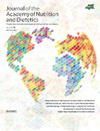Exploring Biases of the Healthy Eating Index and Alternative Healthy Eating Index When Scoring Low-Carbohydrate and Low-Fat Diets
IF 3.5
2区 医学
Q2 NUTRITION & DIETETICS
Journal of the Academy of Nutrition and Dietetics
Pub Date : 2024-02-27
DOI:10.1016/j.jand.2024.02.014
引用次数: 0
Abstract
Background
The Healthy Eating Index 2010 (HEI-2010) and Alternative Healthy Eating Index 2010 (AHEI-2010) are commonly used to measure dietary quality in research settings. Neither index is designed specifically to compare diet quality between low-carbohydrate (LC) and low-fat (LF) diets. It is unknown whether biases exist in making these comparisons.
Objective
The aim was to determine whether HEI-2010 and AHEI-2010 contain biases when scoring LC and LF diets.
Design
Secondary analyses of the Diet Intervention Examining the Factors Interacting With Treatment Success (DIETFITS) weight loss trial were conducted. The trial was conducted in the San Francisco Bay Area of California between January 2013 and May 2016. Three approaches were used to investigate whether biases existed for HEI-2010 and AHEI-2010 when scoring LC and LF diets.
Participants/setting
DIETFITS participants were assigned to follow healthy LC or healthy LF diets for 12 months (n = 609).
Main outcomes measures
Mean diet quality index scores for each diet were measured.
Statistical analysis
Approach 1 examined both diet quality indices’ scoring criteria. Approach 2 compared scores garnered by exemplary quality LC and LF menus created by registered dietitian nutritionists. Approach 3 used 2-sided t tests to compare the HEI-2010 and AHEI-2010 scores calculated from 24-hour dietary recalls of DIETFITS trial participants (n = 608).
Results
Scoring criteria for both HEI-2010 (100 possible points) and AHEI-2010 (110 possible points) were estimated to favor an LF diet by 10 points. Mean scores for exemplary quality LF menus were higher than for LC menus using both HEI-2010 (91.8 vs 76.8) and AHEI-2010 (71.7 vs 64.4, adjusted to 100 possible points). DIETFITS participants assigned to a healthy LF diet scored significantly higher on HEI and AHEI than those assigned to a healthy LC diet at 3, 6, and 12 months (all, P < .001). Mean baseline scores were lower than mean scores at all follow-up time points regardless of diet assignment or diet quality index used.
Conclusions
Commonly used diet quality indices, HEI-2010 and AHEI-2010, showed biases toward LF vs LC diets. However, both indices detected expected changes in diet quality within each diet, with HEI-2010 yielding greater variation in scores. Findings support the use of these indices in measuring diet quality differences within, but not between, LC and LF diets.
探索健康饮食指数和替代健康饮食指数在对低碳水化合物和低脂肪饮食进行评分时的偏差。
背景:健康饮食指数 2010(HEI-2010)和替代性健康饮食指数 2010(AHEI-2010)通常用于测量研究环境中的饮食质量。这两个指数都不是专门用来比较低碳水化合物(LC)和低脂肪(LF)饮食之间的饮食质量的。目前尚不清楚在进行这些比较时是否存在偏差:目的:确定 HEI-2010 和 AHEI-2010 在对低碳水化合物饮食和低脂肪饮食进行评分时是否存在偏差:设计: 对 "饮食干预与治疗成功的相互作用因素"(DIETFITS)减肥试验进行二次分析。该试验于 2013 年 1 月至 2016 年 5 月期间在加利福尼亚州旧金山湾区进行。在对 LC 和 LF 饮食进行评分时,采用了三种方法来调查 HEI-2010 和 AHEI-2010 是否存在偏差:/设置:DIETFITS参与者被分配到健康低碳水化合物(HLC)或健康低脂肪(HLF)饮食,为期12个月(N=609):测量每种饮食的平均饮食质量指数得分:方法 1 研究了两种饮食质量指数的评分标准。方法 2 比较注册营养师制定的示范性低脂和低脂优质菜单所获得的分数。方法 3 使用双侧 t 检验比较根据 DIETFITS 试验参与者(N=608)24 小时膳食回顾计算得出的 HEI-2010 和 AHEI-2010 分数:据估计,HEI-2010(100 分)和 AHEI-2010(110 分)的评分标准均有利于低脂饮食 10 分。在 HEI-2010 和 AHEI-2010 的评分标准(分别为 91.8 分和 76.8 分)和 AHEI-2010 的评分标准(分别为 71.7 分和 64.4 分,调整为 100 分)中,低脂饮食菜单的平均得分均高于低脂饮食菜单。在 3 个月、6 个月和 12 个月时,采用 HLF 饮食的 DIETFITS 参与者在 HEI 和 AHEI 上的得分明显高于采用 HLC 饮食的参与者(所有 p 均为 0):常用的饮食质量指数 HEI-2010 和 AHEI-2010 显示,低脂饮食相对于低脂饮食存在偏差。不过,这两种指数都能检测出每种饮食中饮食质量的预期变化,其中 HEI-2010 的得分差异更大。研究结果支持使用这些指数来测量低脂饮食和低能量饮食内部的饮食质量差异,但不支持使用这些指数来测量低脂饮食和低能量饮食之间的饮食质量差异。
本文章由计算机程序翻译,如有差异,请以英文原文为准。
求助全文
约1分钟内获得全文
求助全文
来源期刊

Journal of the Academy of Nutrition and Dietetics
NUTRITION & DIETETICS-
CiteScore
7.20
自引率
10.40%
发文量
649
审稿时长
68 days
期刊介绍:
The Journal of the Academy of Nutrition and Dietetics is the premier source for the practice and science of food, nutrition, and dietetics. The monthly, peer-reviewed journal presents original articles prepared by scholars and practitioners and is the most widely read professional publication in the field. The Journal focuses on advancing professional knowledge across the range of research and practice issues such as: nutritional science, medical nutrition therapy, public health nutrition, food science and biotechnology, foodservice systems, leadership and management, and dietetics education.
 求助内容:
求助内容: 应助结果提醒方式:
应助结果提醒方式:


